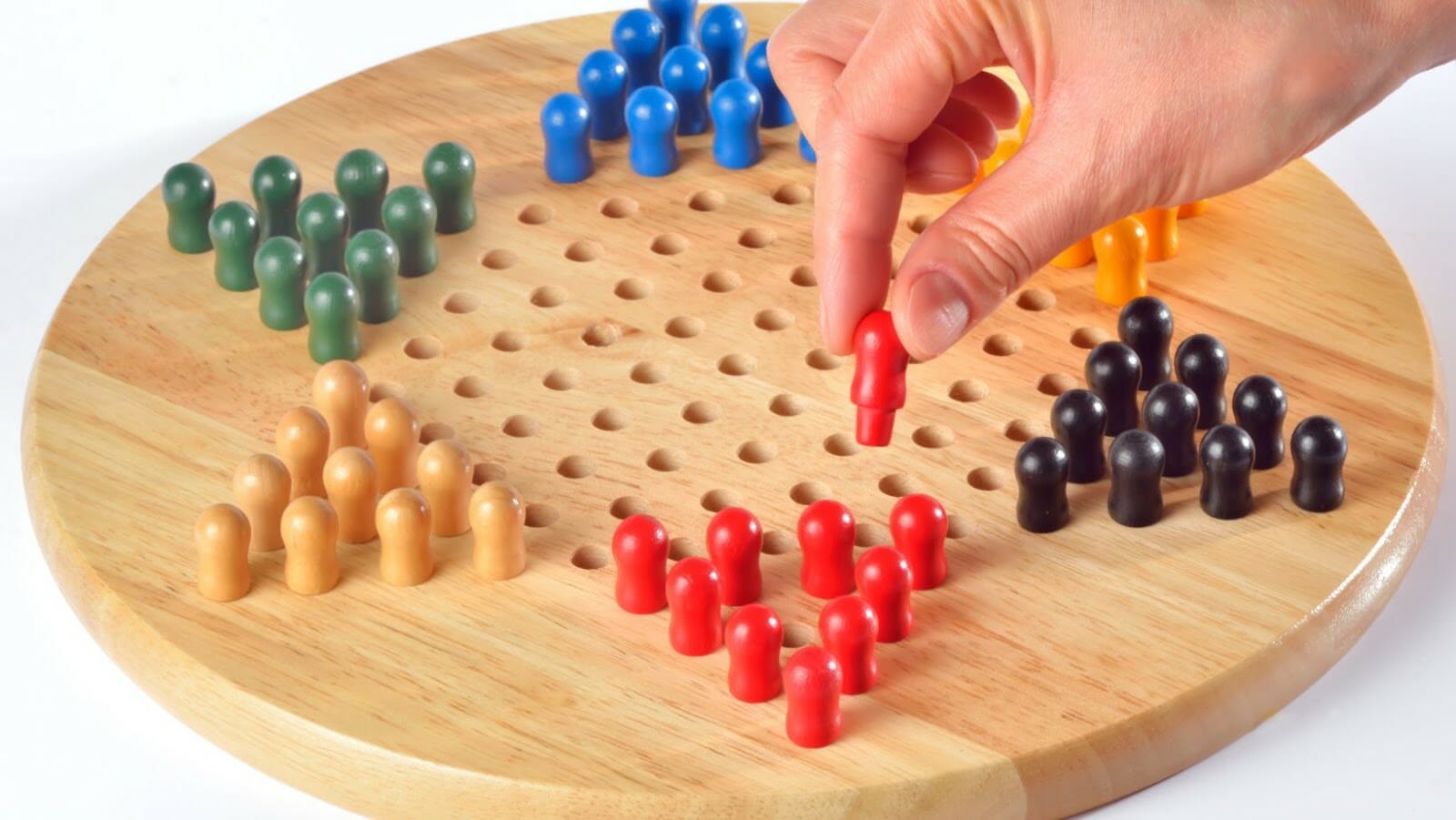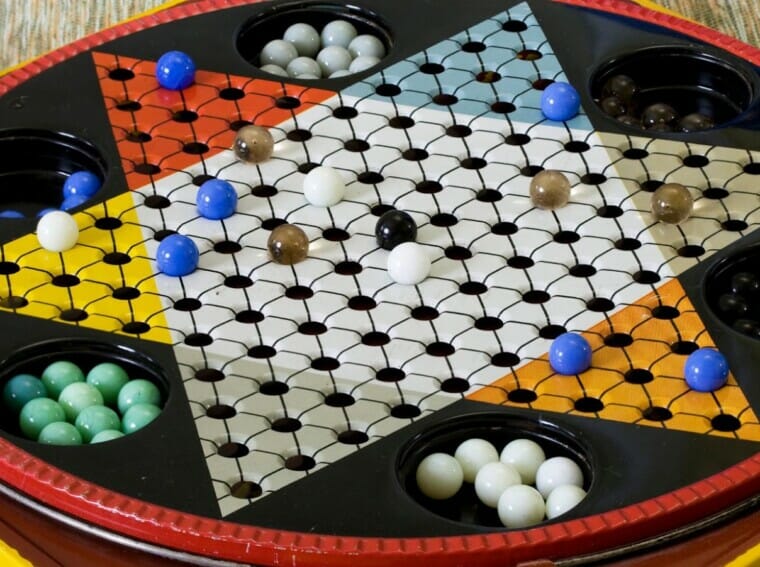Chinese Checkers, sometimes called Halma, is a popular board game that is enjoyed around the world. But did you know that the game was invented in Germany? This article will explore the history of Chinese Checkers and answer the question: In which country was the game invented?
We will examine the game’s origins, the inventor, and how its popularity spread.
In Which Country Was The Game Chinese Checkers Invented
Contrary to its name, Chinese Checkers did not originate in China, but in Germany in the late 19th century. The game was initially known as “Sternhalma” and later renamed “Chinese Checkers” in the United States for marketing purposes. The game’s inventor, George Howard Monks, was inspired by the game of Halma, a British board game with similar gameplay mechanics.
Chinese Checkers gained popularity in the United States in the early 20th century and has since become a classic family game worldwide, enjoyed by players of all ages. Whether played on a wooden board or a digital platform, the game continues to entertain and challenge players, making it a timeless classic that will likely endure for many more decades.
Evolution of the game over time
The game we know as Chinese Checkers originated in Germany in the late 19th century as a variation of a game called Halma. At the time, it was known as “Stern-Halma” and was played on a star-shaped board.
The game was first introduced in the United States in the early 20th century by J. Pressman & Co., who renamed it “Chinese Checkers” to make it sound more exotic and appeal to American consumers.
Since then, the game has become a beloved classic and has been adapted and modified in countless ways, including different board designs, variations in gameplay, and even electronic versions.
Cultural significance of Chinese Checkers
Chinese Checkers is a popular board game that originated in Germany in the late 19th century, despite its name, and has since become a staple worldwide, especially in China and the United States.
The game was originally called “Stern-Halma,” which translates to “Star-Halma,” about the game Halma which it was based on. However, in the 1920s, the game was rebranded as Chinese Checkers in America to give it an exotic appeal, even though it has no known link to Chinese culture or history.
Today, Chinese Checkers is enjoyed by people of all ages and cultural backgrounds, and it has become a powerful symbol of global togetherness and unity.
Pro Tip: Instead of playing traditional Chinese Checkers with 2 to 6 players, try playing a more challenging version with 10 players using a star-shaped board.

Invention Of Chinese Checkers
Chinese Checkers, also known as Halma, is a game that has been popular for generations worldwide. But what many people don’t know is that it was invented in Germany in 1892. Since then, it has been exported to many other countries and transformed into different variations.
In this article, we’ll deeply dive into the history of the game’s invention and the countries it has impacted.
Examining different claims about the game’s invention
Despite its name, Chinese Checkers was not invented in China. However, several claims about the game’s origin make it difficult to pinpoint where the game was first developed.
Many historians believe the game was developed in Germany in the late 1800s and was known as “Stern-Halma” or “Sternhalma”. This version of the game was played on a star-shaped board and was a variation of Halma.
Another claim suggests that the game was invented in the United States by a professor of mathematics named Dr. George Howard Monks. According to this theory, Monks developed the game in 1892 as a variation of the game Halma but with a larger star-shaped board.
However, the game’s popularity in China led to it being marketed as a Chinese game in the United States in the early 1900s. This marketing strategy sparked the game’s name “Chinese Checkers,” which remains today.
Despite the conflicting claims, the fact remains that Chinese Checkers is a popular board game enjoyed by people of all ages around the world.
The role of the game’s Chinese origins in its invention
Chinese Checkers is a classic board game that generations have enjoyed. Despite its name, Chinese Checkers is not a Chinese game, but a game invented in Germany in the late 19th century, inspired by a British game called Halma.
The game’s Chinese origins can be traced back to the game of Halma, which was invented in Britain in the late 19th century. Halma was based on an even older game called Hoppity, also known as “Chinese chequers” due to its similarity to a game played in China.
The game of Halma was later adapted by a German game manufacturer named Ravensburger, who modified the game board and rules to create the game we now know as Chinese Checkers. The new game was an instant hit in the United States and has become a beloved classic.
While Chinese Checkers may not have originated in China, its name and history shows how the game has evolved and taken inspiration from different cultures over time. It is a testament to games’ universality and ability to bring people together across boundaries and borders.
Impact of Chinese Checkers on popular culture
Chinese Checkers have significantly impacted popular culture since its invention in Germany in 1892. Though the game was neither Chinese nor originated in China, it gained immense popularity worldwide due to its simplicity and entertainment value.
Chinese Checkers were invented by a German game designer named George Howard Monks, who based the game on an earlier game called “Halma” invented in England. The game was initially called “Stern-Halma,” Its name was later changed to “Chinese Checkers” in the United States in the early 1920s as a marketing gimmick.
The game’s popularity quickly spread worldwide, and it has since become a beloved classic game enjoyed by people of all ages. Its simple rules and fast-paced gameplay make it a popular choice for family game nights, and it has also been featured in several movies and TV shows, cementing its place in popular culture.
While the game’s origin story is not as exotic as its name implies, its impact on popular culture and entertainment value is undeniable.

Spread Of Chinese Checkers
The game of Chinese Checkers has been around for centuries and has a fascinating history. Most people don’t know, however, the story behind its invention and the journey it has taken to become popular.
This article will explore where Chinese Checkers was first invented and how it spread worldwide.
Marketing and promotion of the game
Chinese Checkers, despite its name, is not actually from China. The game was developed in Germany in the late 19th century by a game designer named George Howard Monks. Over time, the game spread to other countries and gained popularity worldwide. The promotion and marketing of the game played a significant role in its widespread success.
Game manufacturers promoted Chinese Checkers through print media, television, and word of mouth advertising campaigns. They marketed the game as fun for people of all ages and skill levels. They marketed the game as a way to improve problem-solving abilities, strategy skills, and agility. Finally, they introduced various themes in the game to boost interest and promote sales. For instance, the manufacturers introduced a Star Wars-themed Chinese Checkers game, and recently, the Disney princess-themed Chinese Checkers board.
Today, Chinese Checkers can be found in households, schools, and game stores worldwide. The game has spread across multiple cultures and generations for over a century despite its origins being misnamed.
Adoption of Chinese Checkers in different countries
Contrary to popular belief, Chinese Checkers is not Chinese in origin but was invented in Germany in the late 1800s. However, the game quickly gained popularity in various countries worldwide, each with unique variations.
In the United States
Chinese Checkers was marketed as a family-friendly game that anyone could play regardless of age or skill level.
The UK
Known as “Hop Ching Checkers.”
France
Played on a star-shaped board and called “Etoile.”
Italy
Modified to include up to six players and was known as “Mandarin.”
China
Not officially introduced until the 1920s but was quickly embraced by the public and became known as “Damei.”
Today, Chinese Checkers remains a beloved game worldwide, appealing to players of all ages and nationalities due to its easy-to-learn rules and strategic gameplay.
Chinese Checkers today – popularity and variations
Chinese Checkers, a popular board game enjoyed by people of all ages, originated in Germany in the late 19th century. Despite its name, the game has no historical roots in China. The game was originally named Stern-Halma and was rebranded to Chinese Checkers when it was first introduced to the United States in the early 20th century.
The game is played on a six-pointed star-shaped board with marbles or pegs. The game aims to move all your pieces, or marbles, from one side of the board to the opposite through a series of strategic hops.
Since its inception, Chinese Checkers has gained worldwide popularity and has been modified and adapted into various versions. Some popular variations include Grand Chinese Checkers, Super Chinese Checkers, and Circular Chinese Checkers. Each variation has its unique board layout and rules, making it enjoyable for players who want to experience a fresh spin on the classic Stern-Halma.

Conclusion
The game Chinese Checkers was invented in Germany in the early 1900s. Its origins can be traced back to a traditional game called Sternhalma which was popular in Europe. This game was adapted to become the modern version widely known today.
In this article, we have taken an in-depth look into the history behind the origin of the game Chinese Checkers and some interesting facts about the game itself.
Summary of key points
In conclusion, Chinese Checkers is not a Chinese game as the name suggests. It was invented in Germany in the late 19th century and became popular in the United States during the early 20th century. The game’s original name, “Sternhalma,” was changed to Chinese Checkers in the 1920s as a marketing ploy to increase sales.
The game is played on a star-shaped board with ten pieces in different colors. The objective is to move all your pieces from one end of the board to the opposite end before your opponents do. The game promotes strategic thinking and problem-solving skills, making it a popular choice for people of all ages.
Future of Chinese Checkers
Chinese Checkers, a game of strategy, has been enjoyed by people of all ages for over 100 years. However, despite its name, the game was not invented in China. It was created by a German game designer named George Howard Monks in the late 1800s.
However, the game has certainly gained popularity in China, and now you can find versions in almost every home in China.
Looking ahead, it’s safe to say that the future of Chinese Checkers looks bright. With the rise of board games in recent years, people are becoming more interested in classic games like Chinese Checkers. Moreover, the game’s simplicity, portability, and social nature make it ideal for friends and family. Whether at home or on the go, Chinese Checkers is a game that will continue to bring joy and entertainment to players worldwide.
Significance of Chinese Checkers in global culture
Chinese Checkers, despite its name, is not a game native to China. It was invented in Germany in the late 1800s as a variation of an earlier British game called Halma. However, it was marketed in the United States as “Chinese Checkers” in the early 1900s due to the popularity of other games with exotic-sounding names.
Despite its origins, Chinese Checkers has since become a popular game worldwide, with variations played in countries like India, Singapore, and the Philippines. Its simple rules and strategic gameplay have earned it a place in global culture as a beloved family-friendly board game.
Pro Tip: Next time you play Chinese Checkers, impress your friends with your knowledge of its origin story!


